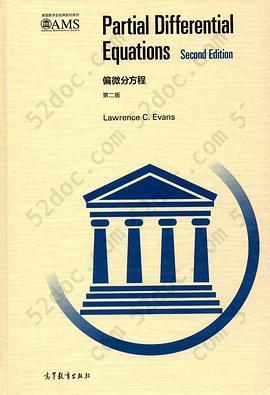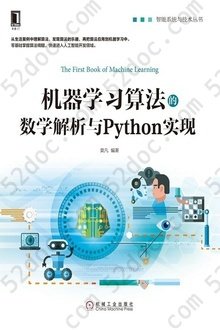注重体验与质量的电子书资源下载网站
分类于: 设计 云计算&大数据
简介

偏微分方程(第二版)(英文版) 豆 9.4分
资源最后更新于 2020-10-05 18:47:38
作者:Lawrence C. Evans
出版社:高等教育出版社
出版日期:2017-01
ISBN:9787040469356
文件格式: pdf
标签: 数学 偏微分方程 美国数学会经典影印 PDE 微分方程 数学物理 Math 数学物理方程
简介· · · · · ·
这是当今关于偏微分方程 (PDE) 的最权威教材的第二版。它给出了PDE理论学习中现代技术的总览,特别注重非线性方程。本书内容广泛,阐述清晰,已经是PDE方面经典的研究生教材。在本版中,作者做了大量改动,包括:
新增非线性波动方程的一章,
超过 80 个新习题,
许多新的小节,
大大扩充了参考文献。
目录
CONTENTS
Preface to second edition xvii
Preface to first edition xix
1. Introduction 1
1.1. Partial differential equations 1
1.2. Examples 3
1.2.1. Single partial differential equations 3
1.2.2. Systems of partial differential equations 6
1.3. Strategies for studying PDE 6
1.3.1. Well-posed problems, classical solutions 7
1.3.2. Weak solutions and regularity 7
1.3.3. Typical difficulties 9
1.4. Overview 9
1.5. Problems 12
1.6. References 13
PART I: REPRESENTATION FORMULAS
FOR SOLUTIONS
2. Four Important Linear PDE 17
2.1. Transport equation 18
2.1.1. Initial-value problem 18
2.1.2. Nonhomogeneous problem 19
2.2. Laplace's equation 20
2.2.1. Fundamental solution 21
2.2.2. Mean-value formulas 25
2.2.3. Properties of harmonic functions 26
2.2.4. Green's function 33
2.2.5. Energy methods 41
2.3. Heat equation 44
2.3.1. Fundamental solution 45
2.3.2. Mean-value formula 51
2.3.3. Properties of solutions 55
2.3.4. Energy methods 62
2.4. Wave equation 65
2.4.1. Solution by spherical means 67
2.4.2. Nonhomogeneous problem 80
2.4.3. Energy methods 82
2.5. Problems 84
2.6. References 90
3. Nonlinear First-Order PDE 91
3.1. Complete integrals, envelopes 92
3.1.1. Complete integrals 92
3.1.2. New solutions from envelopes 94
3.2. Characteristics 96
3.2.1. Derivation of characteristic ODE 96
3.2.2. Examples 99
3.2.3. Boundary conditions 102
3.2.4. Local solution 105
3.2.5. Applications 109
3.3. Introduction to Hamilton-Jacobi equations 114
3.3.1. Calculus of variations, Hamilton's ODE 115
3.3.2. Legendre transform, Hopf-Lax formula 120
3.3.3. Weak solutions, uniqueness 128
3.4. Introduction to conservation laws 135
3.4.1. Shocks, entropy condition 136
3.4.2. Lax-Oleinik formula 143
3.4.3. Weak solutions, uniqueness 148
3.4.4. Riemann's problem 153
3.4.5. Long time behavior 156
3.5. Problems 161
3.6. References 165
4. Other Ways to Represent Solutions 167
4.1. Separation of variables 167
4.1.1. Examples 168
4.1.2. Application: Turing instability 172
4.2. Similarity solutions 176
4.2.1. Plane and traveling waves, solitons 176
4.2.2. Similarity under scaling 185
4.3. Transform methods 187
4.3.1. Fourier transform 187
4.3.2. Radon transform 196
4.3.3. Laplace transform 203
4.4. Converting nonlinear into linear PDE 206
4.4.1. Cole-Hopf transformation 206
4.4.2. Potential functions 208
4.4.3. Hodograph and Legendre transforms 209
4.5. Asymptotics 211
4.5.1. Singular perturbations 211
4.5.2. Laplace's method 216
4.5.3. Geometric optics, stationary phase 218
4.5.4. Homogenization 229
4.6. Power series 232
4.6.1. Noncharacteristic surfaces 232
4.6.2. Real analytic functions 237
4.6.3. Cauchy-Kovalevskaya Theorem 239
4.7. Problems 244
4.8. References 249
PART II: THEORY FOR LINEAR PARTIAL
DIFFERENTIAL EQUATIONS
5. Sobolev Spaces 253
5.1. Holder spaces 254
5.2. Sobolev spaces 255
5.2.1. Weak derivatives 255
5.2.2. Definition of Sobolev spaces 258
5.2.3. Elementary properties 261
5.3. Approximation 264
5.3.1. Interior approximation by smooth functions . . . 264
5.3.2. Approximation by smooth functions 265
5.3.3. Global approximation by smooth functions .... 266
5.4. Extensions 268
5.5. Traces 271
5.6. Sobolev inequalities 275
5.6.1. Gagliardo-Nirenberg-Sobolev inequality 276
5.6.2. Morrey's inequality 280
5.6.3. General Sobolev inequalities 284
5.7. Compactness 286
5.8. Additional topics 289
5.8.1. Poincare's inequalities 289
5.8.2. Difference quotients 291
5.8.3. Differentiability a.e 295
5.8.4. Hardy's inequality 296
5.8.5. Fourier transform methods 297
5.9. Other spaces of functions 299
5.9.1. The space Я"1 299
5.9.2. Spaces involving time 301
5.10. Problems 305
5.11. References 309
6. Second-Order Elliptic Equations 311
6.1. Definitions 311
6.1.1. Elliptic equations 311
6.1.2. Weak solutions 313
6.2. Existence of weak solutions 315
6.2.1. Lax-Milgram Theorem 315
6.2.2. Energy estimates 317
6.2.3. Fredholm alternative 320
6.3. Regularity 326
6.3.1. Interior regularity 327
6.3.2. Boundary regularity 334
6.4. Maximum principles 344
6.4.1. Weak maximum principle 344
6.4.2. Strong maximum principle 347
6.4.3. Harnack's inequality 351
6.5. Eigenvalues and eigenfunctions 354
6.5.1. Eigenvalues of symmetric elliptic operators .... 354
6.5.2. Eigenvalues of nonsymmetric elliptic operators . 360
6.6. Problems 365
6.7. References 370
7. Linear Evolution Equations 371
7.1. Second-order parabolic equations 371
7.1.1. Definitions 372
7.1.2. Existence of weak solutions 375
7.1.3. Regularity 380
7.1.4. Maximum principles 389
7.2. Second-order hyperbolic equations 398
7.2.1. Definitions 398
7.2.2. Existence of weak solutions 401
7.2.3. Regularity 408
7.2.4. Propagation of disturbances 414
7.2.5. Equations in two variables 418
7.3. Hyperbolic systems of first-order equations 421
7.3.1. Definitions 421
7.3.2. Symmetric hyperbolic systems 423
7.3.3. Systems with constant coefficients 429
7.4. Semigroup theory 433
7.4.1. Definitions, elementary properties 434
7.4.2. Generating contraction semigroups 439
7.4.3. Applications 441
7.5. Problems 446
7.6. References 449
PART III: THEORY FOR NONLINEAR PARTIAL
DIFFERENTIAL EQUATIONS
8. The Calculus of Variations 453
8.1. Introduction 453
8.1.1. Basic ideas 453
8.1.2. First variation, Euler-Lagrange equation 454
8.1.3. Second variation 458
8.1.4. Systems 459
8.2. Existence of minimizers 465
8.2.1. Coercivity, lower semicontinuity 465
8.2.2. Convexity 467
8.2.3. Weak solutions of Euler-Lagrange equation . . . 472
8.2.4. Systems 475
8.2.5. Local minimizers 480
8.3. Regularity 482
8.3.1. Second derivative estimates 483
8.3.2. Remarks on higher regularity 486
8.4. Constraints 488
8.4.1. Nonlinear eigenvalue problems 488
8.4.2. Unilateral constraints, variational inequalities . 492
8.4.3. Harmonic maps 495
8.4.4. Incompressibility 497
8.5. Critical points 501
8.5.1. Mountain Pass Theorem 501
8.5.2. Application to semilinear elliptic PDE 507
8.6. Invariance, Noether's Theorem 511
8.6.1. Invariant variational problems 512
8.6.2. Noether's Theorem 513
8.7. Problems 520
8.8. References 525
9. Nonvariational Techniques 527
9.1. Monotonicity methods 527
9.2. Fixed point methods 533
9.2.1. Banach's Fixed Point Theorem 534
9.2.2. Schauder's, Schaefer's Fixed Point Theorems . . 538
9.3. Method of subsolutions and supersolutions 543
9.4. Nonexistence of solutions 547
9.4.1. Blow-up 547
9.4.2. Derrick-Pohozaev identity 551
9.5. Geometric properties of solutions 554
9.5.1. Star-shaped level sets 554
9.5.2. Radial symmetry 555
9.6. Gradient flows 560
9.6.1. Convex functions on Hilbert spaces 560
9.6.2. Subdifferentials and nonlinear semigroups .... 565
9.6.3. Applications 571
9.7. Problems 573
9.8. References 577
10. Hamilton—Jacobi Equations 579
10.1. Introduction, viscosity solutions 579
10.1.1. Definitions 581
10.1.2. Consistency 583
10.2. Uniqueness 586
10.3. Control theory, dynamic programming 590
10.3.1. Introduction to optimal control theory 591
10.3.2. Dynamic programming 592
10.3.3. Hamilton-Jacobi-Bellman equation 594
10.3.4. Hopf-Lax formula revisited 600
10.4. Problems 603
10.5. References 606
11. Systems of Conservation Laws 609
11.1. Introduction 609
11.1.1. Integral solutions 612
11.1.2. Traveling waves, hyperbolic systems 615
11.2. Riemann's problem 621
11.2.1. Simple waves 621
11.2.2. Rarefaction waves 624
11.2.3. Shock waves, contact discontinuities 625
11.2.4. Local solution of Riemann's problem 632
11.3. Systems of two conservation laws 635
11.3.1. Riemann invariants 635
11.3.2. Nonexistence of smooth solutions 639
11.4. Entropy criteria 641
11.4.1. Vanishing viscosity, traveling waves 642
11.4.2. Entropy/entropy-flux pairs 646
11.4.3. Uniqueness for scalar conservation laws 649
11.5. Problems 654
11.6. References 657
12. Nonlinear Wave Equations 659
12.1. Introduction 659
12.1.1. Conservation of energy 660
12.1.2. Finite propagation speed 660
12.2. Existence of solutions 663
12.2.1. Lipschitz nonlinearities 663
12.2.2. Short time existence 666
12.3. Semilinear wave equations 670
12.3.1. Sign conditions 670
12.3.2. Three space dimensions 674
12.3.3. Subcritical power nonlinearities 676
12.4. Critical power nonlinearity 679
12.5. Nonexistence of solutions 686
12.5.1. Nonexistence for negative energy 687
12.5.2. Nonexistence for small initial data 689
12.6. Problems 691
12.7. References 696
APPENDICES
Appendix A: Notation 697
A.l. Notation for matrices 697
A.2. Geometric notation 698
A.3. Notation for functions 699
A.4. Vector-valued functions 703
A.5. Notation for estimates 703
A.6. Some comments about notation 704
Appendix B: Inequalities 705
B.l. Convex functions 705
B.2. Useful inequalities 706
Appendix C: Calculus 710
C.l. Boundaries 710
C.2. Gauss-Green Theorem 711
C.3. Polar coordinates, coarea formula 712
C.4. Moving regions 713
C.5. Convolution and smoothing 713
C.6. Inverse Function Theorem 716
C.7. Implicit Function Theorem 717
C.8. Uniform convergence 718
Appendix D: Functional Analysis 719
D.l. Banach spaces 719
D.2. Hilbert spaces 720
D.3. Bounded linear operators 721
D.4. Weak convergence 723
D.5. Compact operators, Fredholm theory 724
D.6. Symmetric operators 728
Appendix E: Measure Theory 729
E.l. Lebesgue measure 729
E.2. Measurable functions and integration 730
E.3. Convergence theorems for integrals 731
E.4. Differentiation 732
E.5. Banach space-valued functions 733
Bibliography 735
Index 741
Preface to second edition xvii
Preface to first edition xix
1. Introduction 1
1.1. Partial differential equations 1
1.2. Examples 3
1.2.1. Single partial differential equations 3
1.2.2. Systems of partial differential equations 6
1.3. Strategies for studying PDE 6
1.3.1. Well-posed problems, classical solutions 7
1.3.2. Weak solutions and regularity 7
1.3.3. Typical difficulties 9
1.4. Overview 9
1.5. Problems 12
1.6. References 13
PART I: REPRESENTATION FORMULAS
FOR SOLUTIONS
2. Four Important Linear PDE 17
2.1. Transport equation 18
2.1.1. Initial-value problem 18
2.1.2. Nonhomogeneous problem 19
2.2. Laplace's equation 20
2.2.1. Fundamental solution 21
2.2.2. Mean-value formulas 25
2.2.3. Properties of harmonic functions 26
2.2.4. Green's function 33
2.2.5. Energy methods 41
2.3. Heat equation 44
2.3.1. Fundamental solution 45
2.3.2. Mean-value formula 51
2.3.3. Properties of solutions 55
2.3.4. Energy methods 62
2.4. Wave equation 65
2.4.1. Solution by spherical means 67
2.4.2. Nonhomogeneous problem 80
2.4.3. Energy methods 82
2.5. Problems 84
2.6. References 90
3. Nonlinear First-Order PDE 91
3.1. Complete integrals, envelopes 92
3.1.1. Complete integrals 92
3.1.2. New solutions from envelopes 94
3.2. Characteristics 96
3.2.1. Derivation of characteristic ODE 96
3.2.2. Examples 99
3.2.3. Boundary conditions 102
3.2.4. Local solution 105
3.2.5. Applications 109
3.3. Introduction to Hamilton-Jacobi equations 114
3.3.1. Calculus of variations, Hamilton's ODE 115
3.3.2. Legendre transform, Hopf-Lax formula 120
3.3.3. Weak solutions, uniqueness 128
3.4. Introduction to conservation laws 135
3.4.1. Shocks, entropy condition 136
3.4.2. Lax-Oleinik formula 143
3.4.3. Weak solutions, uniqueness 148
3.4.4. Riemann's problem 153
3.4.5. Long time behavior 156
3.5. Problems 161
3.6. References 165
4. Other Ways to Represent Solutions 167
4.1. Separation of variables 167
4.1.1. Examples 168
4.1.2. Application: Turing instability 172
4.2. Similarity solutions 176
4.2.1. Plane and traveling waves, solitons 176
4.2.2. Similarity under scaling 185
4.3. Transform methods 187
4.3.1. Fourier transform 187
4.3.2. Radon transform 196
4.3.3. Laplace transform 203
4.4. Converting nonlinear into linear PDE 206
4.4.1. Cole-Hopf transformation 206
4.4.2. Potential functions 208
4.4.3. Hodograph and Legendre transforms 209
4.5. Asymptotics 211
4.5.1. Singular perturbations 211
4.5.2. Laplace's method 216
4.5.3. Geometric optics, stationary phase 218
4.5.4. Homogenization 229
4.6. Power series 232
4.6.1. Noncharacteristic surfaces 232
4.6.2. Real analytic functions 237
4.6.3. Cauchy-Kovalevskaya Theorem 239
4.7. Problems 244
4.8. References 249
PART II: THEORY FOR LINEAR PARTIAL
DIFFERENTIAL EQUATIONS
5. Sobolev Spaces 253
5.1. Holder spaces 254
5.2. Sobolev spaces 255
5.2.1. Weak derivatives 255
5.2.2. Definition of Sobolev spaces 258
5.2.3. Elementary properties 261
5.3. Approximation 264
5.3.1. Interior approximation by smooth functions . . . 264
5.3.2. Approximation by smooth functions 265
5.3.3. Global approximation by smooth functions .... 266
5.4. Extensions 268
5.5. Traces 271
5.6. Sobolev inequalities 275
5.6.1. Gagliardo-Nirenberg-Sobolev inequality 276
5.6.2. Morrey's inequality 280
5.6.3. General Sobolev inequalities 284
5.7. Compactness 286
5.8. Additional topics 289
5.8.1. Poincare's inequalities 289
5.8.2. Difference quotients 291
5.8.3. Differentiability a.e 295
5.8.4. Hardy's inequality 296
5.8.5. Fourier transform methods 297
5.9. Other spaces of functions 299
5.9.1. The space Я"1 299
5.9.2. Spaces involving time 301
5.10. Problems 305
5.11. References 309
6. Second-Order Elliptic Equations 311
6.1. Definitions 311
6.1.1. Elliptic equations 311
6.1.2. Weak solutions 313
6.2. Existence of weak solutions 315
6.2.1. Lax-Milgram Theorem 315
6.2.2. Energy estimates 317
6.2.3. Fredholm alternative 320
6.3. Regularity 326
6.3.1. Interior regularity 327
6.3.2. Boundary regularity 334
6.4. Maximum principles 344
6.4.1. Weak maximum principle 344
6.4.2. Strong maximum principle 347
6.4.3. Harnack's inequality 351
6.5. Eigenvalues and eigenfunctions 354
6.5.1. Eigenvalues of symmetric elliptic operators .... 354
6.5.2. Eigenvalues of nonsymmetric elliptic operators . 360
6.6. Problems 365
6.7. References 370
7. Linear Evolution Equations 371
7.1. Second-order parabolic equations 371
7.1.1. Definitions 372
7.1.2. Existence of weak solutions 375
7.1.3. Regularity 380
7.1.4. Maximum principles 389
7.2. Second-order hyperbolic equations 398
7.2.1. Definitions 398
7.2.2. Existence of weak solutions 401
7.2.3. Regularity 408
7.2.4. Propagation of disturbances 414
7.2.5. Equations in two variables 418
7.3. Hyperbolic systems of first-order equations 421
7.3.1. Definitions 421
7.3.2. Symmetric hyperbolic systems 423
7.3.3. Systems with constant coefficients 429
7.4. Semigroup theory 433
7.4.1. Definitions, elementary properties 434
7.4.2. Generating contraction semigroups 439
7.4.3. Applications 441
7.5. Problems 446
7.6. References 449
PART III: THEORY FOR NONLINEAR PARTIAL
DIFFERENTIAL EQUATIONS
8. The Calculus of Variations 453
8.1. Introduction 453
8.1.1. Basic ideas 453
8.1.2. First variation, Euler-Lagrange equation 454
8.1.3. Second variation 458
8.1.4. Systems 459
8.2. Existence of minimizers 465
8.2.1. Coercivity, lower semicontinuity 465
8.2.2. Convexity 467
8.2.3. Weak solutions of Euler-Lagrange equation . . . 472
8.2.4. Systems 475
8.2.5. Local minimizers 480
8.3. Regularity 482
8.3.1. Second derivative estimates 483
8.3.2. Remarks on higher regularity 486
8.4. Constraints 488
8.4.1. Nonlinear eigenvalue problems 488
8.4.2. Unilateral constraints, variational inequalities . 492
8.4.3. Harmonic maps 495
8.4.4. Incompressibility 497
8.5. Critical points 501
8.5.1. Mountain Pass Theorem 501
8.5.2. Application to semilinear elliptic PDE 507
8.6. Invariance, Noether's Theorem 511
8.6.1. Invariant variational problems 512
8.6.2. Noether's Theorem 513
8.7. Problems 520
8.8. References 525
9. Nonvariational Techniques 527
9.1. Monotonicity methods 527
9.2. Fixed point methods 533
9.2.1. Banach's Fixed Point Theorem 534
9.2.2. Schauder's, Schaefer's Fixed Point Theorems . . 538
9.3. Method of subsolutions and supersolutions 543
9.4. Nonexistence of solutions 547
9.4.1. Blow-up 547
9.4.2. Derrick-Pohozaev identity 551
9.5. Geometric properties of solutions 554
9.5.1. Star-shaped level sets 554
9.5.2. Radial symmetry 555
9.6. Gradient flows 560
9.6.1. Convex functions on Hilbert spaces 560
9.6.2. Subdifferentials and nonlinear semigroups .... 565
9.6.3. Applications 571
9.7. Problems 573
9.8. References 577
10. Hamilton—Jacobi Equations 579
10.1. Introduction, viscosity solutions 579
10.1.1. Definitions 581
10.1.2. Consistency 583
10.2. Uniqueness 586
10.3. Control theory, dynamic programming 590
10.3.1. Introduction to optimal control theory 591
10.3.2. Dynamic programming 592
10.3.3. Hamilton-Jacobi-Bellman equation 594
10.3.4. Hopf-Lax formula revisited 600
10.4. Problems 603
10.5. References 606
11. Systems of Conservation Laws 609
11.1. Introduction 609
11.1.1. Integral solutions 612
11.1.2. Traveling waves, hyperbolic systems 615
11.2. Riemann's problem 621
11.2.1. Simple waves 621
11.2.2. Rarefaction waves 624
11.2.3. Shock waves, contact discontinuities 625
11.2.4. Local solution of Riemann's problem 632
11.3. Systems of two conservation laws 635
11.3.1. Riemann invariants 635
11.3.2. Nonexistence of smooth solutions 639
11.4. Entropy criteria 641
11.4.1. Vanishing viscosity, traveling waves 642
11.4.2. Entropy/entropy-flux pairs 646
11.4.3. Uniqueness for scalar conservation laws 649
11.5. Problems 654
11.6. References 657
12. Nonlinear Wave Equations 659
12.1. Introduction 659
12.1.1. Conservation of energy 660
12.1.2. Finite propagation speed 660
12.2. Existence of solutions 663
12.2.1. Lipschitz nonlinearities 663
12.2.2. Short time existence 666
12.3. Semilinear wave equations 670
12.3.1. Sign conditions 670
12.3.2. Three space dimensions 674
12.3.3. Subcritical power nonlinearities 676
12.4. Critical power nonlinearity 679
12.5. Nonexistence of solutions 686
12.5.1. Nonexistence for negative energy 687
12.5.2. Nonexistence for small initial data 689
12.6. Problems 691
12.7. References 696
APPENDICES
Appendix A: Notation 697
A.l. Notation for matrices 697
A.2. Geometric notation 698
A.3. Notation for functions 699
A.4. Vector-valued functions 703
A.5. Notation for estimates 703
A.6. Some comments about notation 704
Appendix B: Inequalities 705
B.l. Convex functions 705
B.2. Useful inequalities 706
Appendix C: Calculus 710
C.l. Boundaries 710
C.2. Gauss-Green Theorem 711
C.3. Polar coordinates, coarea formula 712
C.4. Moving regions 713
C.5. Convolution and smoothing 713
C.6. Inverse Function Theorem 716
C.7. Implicit Function Theorem 717
C.8. Uniform convergence 718
Appendix D: Functional Analysis 719
D.l. Banach spaces 719
D.2. Hilbert spaces 720
D.3. Bounded linear operators 721
D.4. Weak convergence 723
D.5. Compact operators, Fredholm theory 724
D.6. Symmetric operators 728
Appendix E: Measure Theory 729
E.l. Lebesgue measure 729
E.2. Measurable functions and integration 730
E.3. Convergence theorems for integrals 731
E.4. Differentiation 732
E.5. Banach space-valued functions 733
Bibliography 735
Index 741








